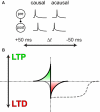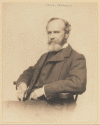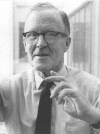A history of spike-timing-dependent plasticity
- PMID: 22007168
- PMCID: PMC3187646
- DOI: 10.3389/fnsyn.2011.00004
A history of spike-timing-dependent plasticity
Abstract
How learning and memory is achieved in the brain is a central question in neuroscience. Key to today's research into information storage in the brain is the concept of synaptic plasticity, a notion that has been heavily influenced by Hebb's (1949) postulate. Hebb conjectured that repeatedly and persistently co-active cells should increase connective strength among populations of interconnected neurons as a means of storing a memory trace, also known as an engram. Hebb certainly was not the first to make such a conjecture, as we show in this history. Nevertheless, literally thousands of studies into the classical frequency-dependent paradigm of cellular learning rules were directly inspired by the Hebbian postulate. But in more recent years, a novel concept in cellular learning has emerged, where temporal order instead of frequency is emphasized. This new learning paradigm - known as spike-timing-dependent plasticity (STDP) - has rapidly gained tremendous interest, perhaps because of its combination of elegant simplicity, biological plausibility, and computational power. But what are the roots of today's STDP concept? Here, we discuss several centuries of diverse thinking, beginning with philosophers such as Aristotle, Locke, and Ribot, traversing, e.g., Lugaro's plasticità and Rosenblatt's perceptron, and culminating with the discovery of STDP. We highlight interactions between theoretical and experimental fields, showing how discoveries sometimes occurred in parallel, seemingly without much knowledge of the other field, and sometimes via concrete back-and-forth communication. We point out where the future directions may lie, which includes interneuron STDP, the functional impact of STDP, its mechanisms and its neuromodulatory regulation, and the linking of STDP to the developmental formation and continuous plasticity of neuronal networks.
Keywords: bidirectional plasticity; history; learning; long term depression; long term plasticity; memory; spike-timing-dependent plasticity; synaptic plasticity.
Figures







Similar articles
-
Hebbian Spike-Timing Dependent Plasticity at the Cerebellar Input Stage.J Neurosci. 2017 Mar 15;37(11):2809-2823. doi: 10.1523/JNEUROSCI.2079-16.2016. Epub 2017 Feb 10. J Neurosci. 2017. PMID: 28188217 Free PMC article.
-
Spike timing-dependent plasticity and memory.Curr Opin Neurobiol. 2023 Jun;80:102707. doi: 10.1016/j.conb.2023.102707. Epub 2023 Mar 14. Curr Opin Neurobiol. 2023. PMID: 36924615 Review.
-
Emergence and maintenance of modularity in neural networks with Hebbian and anti-Hebbian inhibitory STDP.PLoS Comput Biol. 2025 Apr 22;21(4):e1012973. doi: 10.1371/journal.pcbi.1012973. eCollection 2025 Apr. PLoS Comput Biol. 2025. PMID: 40262082 Free PMC article.
-
Environmental enrichment shapes striatal spike-timing-dependent plasticity in vivo.Sci Rep. 2019 Dec 19;9(1):19451. doi: 10.1038/s41598-019-55842-z. Sci Rep. 2019. PMID: 31857605 Free PMC article.
-
Does spike timing-dependent synaptic plasticity underlie memory formation?Clin Exp Pharmacol Physiol. 2007 Oct;34(10):1070-6. doi: 10.1111/j.1440-1681.2007.04724.x. Clin Exp Pharmacol Physiol. 2007. PMID: 17714096 Review.
Cited by
-
Hebbian and anti-Hebbian spike-timing-dependent plasticity of human cortico-cortical connections.J Neurosci. 2013 Jun 5;33(23):9725-33. doi: 10.1523/JNEUROSCI.4988-12.2013. J Neurosci. 2013. PMID: 23739969 Free PMC article.
-
An Integrated World Modeling Theory (IWMT) of Consciousness: Combining Integrated Information and Global Neuronal Workspace Theories With the Free Energy Principle and Active Inference Framework; Toward Solving the Hard Problem and Characterizing Agentic Causation.Front Artif Intell. 2020 Jun 9;3:30. doi: 10.3389/frai.2020.00030. eCollection 2020. Front Artif Intell. 2020. PMID: 33733149 Free PMC article.
-
Paired associative transspinal and transcortical stimulation produces plasticity in human cortical and spinal neuronal circuits.J Neurophysiol. 2016 Aug 1;116(2):904-16. doi: 10.1152/jn.00259.2016. Epub 2016 Jun 8. J Neurophysiol. 2016. PMID: 27281748 Free PMC article.
-
Activation of PLCβ1 enhances endocannabinoid mobilization to restore hippocampal spike-timing-dependent potentiation and contextual fear memory impaired by Alzheimer's amyloidosis.Alzheimers Res Ther. 2021 Oct 8;13(1):165. doi: 10.1186/s13195-021-00901-9. Alzheimers Res Ther. 2021. PMID: 34625112 Free PMC article.
-
Modulation of human corticospinal excitability by paired associative stimulation.Front Hum Neurosci. 2013 Dec 3;7:823. doi: 10.3389/fnhum.2013.00823. Front Hum Neurosci. 2013. PMID: 24348369 Free PMC article. Review.
References
-
- Abeles M. (1991). Corticonics: Neural Circuits of the Cerebral Cortex. Cambridge: Cambridge University Press
Grants and funding
LinkOut - more resources
Full Text Sources
Other Literature Sources

